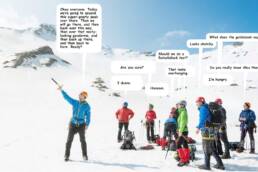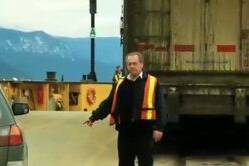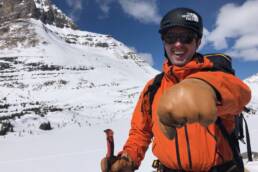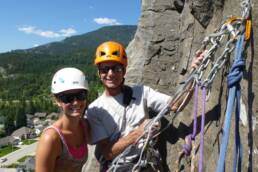With avalanche accident statistics showing the need for increased client-and-guide interaction in decision-making, professional mountain guides are learning new ropes. By Ryan Stuart.
Ours was a cast destined for disaster: an intimidating, yet charismatic, ski guide known for pushing boundaries; a would-be assistant keen to impress; and, a course full of leadership students wanting to learn. Looking back, it almost seemed inevitable that at some point during the trip, high in the Canadian Rockies, I’d be scanning avalanche debris pouring into a crevasse, hoping I wouldn’t see our assistant guide disappear with it. Despite a whole bunch of obvious clues—two feet of fresh snow on an ice crust that slid all around us—it only took one benign snow pit test for the assistant guide to decide we should ski the slope. Afterwards, several of us would admit to being uncomfortable about the decision, but at the time no one spoke up. It was the perfect example of what Avalanche Canada deems “human factors” at play.
Ego, mood, poor communication, competition, peer pressure, money, ambition: everything that makes us human influences our decisions and is the cause of almost every avalanche accident. That’s why in recent years, human factors have taken over from snow pits and weather observations as the key to avalanche safety. The philosophy of “guide knows best” and the client follows unquestioningly is dying, leaving the rest of us with a new level of responsibility.
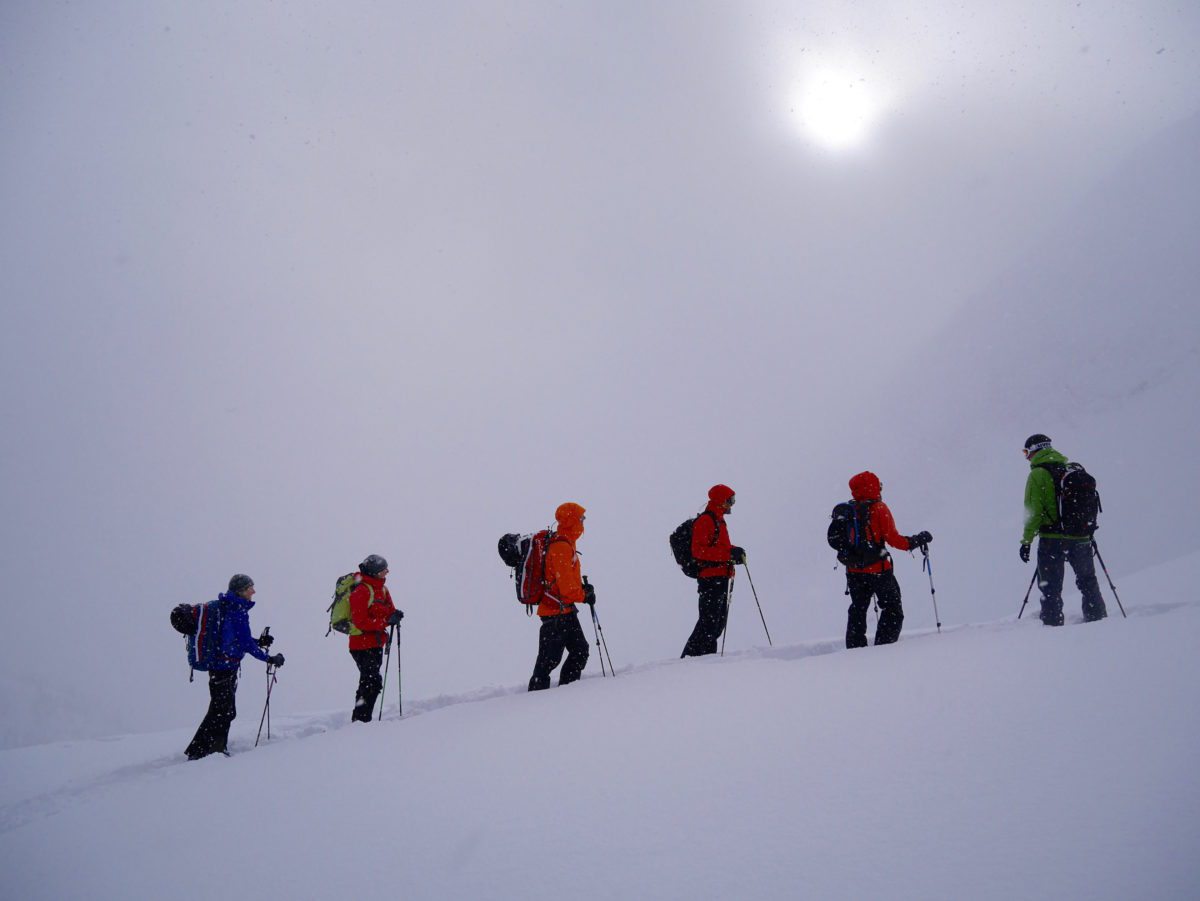
“The guiding culture 20 years ago was not to discuss your decisions with your clients,” says Marty Schaffer, a full ski guide and owner of CAPOW, a ski guiding and education company based in Revelstoke, British Columbia.
It used to be that guides would decide on the plan for the day with no discussion of weather, avalanche conditions, guest concerns or feelings. Today, some backcountry lodges, helicopter and cat ski operations still run like that, and for good reason. It’s a big part of why people go to these places: they want someone with more experience to lead the way.
Ego, mood, poor communication, competition, peer pressure, money, ambition: everything that makes us human influences our decisions and is the cause of almost every avalanche accident.
“A lot of people just want to ski,” says Schaffer. “They don’t want to make decisions.” The problem with that attitude is that it doesn’t encourage the sharing of information or concerns. And that can lead to disaster. When Avalanche Canada reviewed accidents in the 1990s, it found that avalanche professionals were good at collecting data and analyzing it but not good at making safe decisions when it counted. Human factors were getting in the way. In 2001, the organization started adding modules to many of its training programs to teach things like group dynamics, outside pressures, personal traits and how they all affected the decision-making process. The Association of Canadian Mountain Guides followed, adding soft skills like monitoring and communicating with clients to the training and assessing it uses to certify guides. And for existing guides, they introduced continuing development requirements, including sessions on human factors. The latter program is only a few years old and so far 10 percent of ACMG’s 1,250 guides have enrolled.
Schaffer, 31, became a full ski guide around the time the mindset changed. He made communication the focus of his guiding; his morning meetings involve all the clients as well as the guides, and they talk about everything from weather to objectives.
“It stimulates conversation and sets the tone for the day,” he says. “When we head out the door, everyone is on the same page. It gives a lot more respect to the client.”
At every break or shift in terrain, he keeps the conversation going and looks for everyone in the group to participate, even if it’s to say they’re tired. Essentially, it’s taking everything guides already do and putting it out there into the mountain air, thereby creating a platform so everyone feels more comfortable.
“The guiding culture 20 years ago was not to discuss your decisions with your clients.” – Ski guide Marty Schaffer
“Guides make mistakes,” says Dave Stark, director of operations at Yamnuska Mountain School. “Speak up. The more eyes the better for making observations.”
He encouragers the clients of ski guides to stay engaged, rather than follow blindly. Start by asking questions (but don’t confront) such as, “Why are we skiing here, not there?” and “What are you feeling in the snow?” Also, if you see an obvious sign of instability, it’s important to speak up. Chances are the guide already noticed it but the more communication the better.
“It creates an opportunity to rethink what we’re doing,” says Stark. And it’s also important to remember you can always say no. After all, it is your life. Or maybe someone else’s.
That’s the biggest lesson I took home from that avalanche accident in the Rockies. Sure, it was the assistant guide’s decision to ski that slope. But none of us questioned him. We were all guilty, and that’s what I felt in the pit of my stomach until I heard the sweetest words: “I’m okay.” He’d managed to ski out of the slide and away from the crevasse towards safety. When the assistant guide got back up to us it was hugs all ’round. Then we did what we should have done before he dropped in. We started talking.
Ryan Stuart
Ryan Stuart has been fascinated by the natural world since he was a kid, and he’s now sharing this interest through his freelance writing, which he does from Comox on Vancouver Island, British Columbia.
Related Stories
New West Kootenay Backcountry Guide
The first of it's kind for the region, the newly minted West Kootenay Touring Guide provides backcountry riders with…
Get Rich or Be a Guide
Either way, you want to get yourself to CMH Galena. Dream big young warrior. Someone's got to do it. CMH Galena Set-up…
History of Ski Aerial Acrobatics
One of the most influential ski films of all time. Dick Barrymores documents what started freestyle skiing. From 1969…
Powder Highway Ski Bum at SWS
Chris Tatsuno has done an amazing job chronicling his Ultimate Ski Bum Powder Highway winnings. In this episode he…
What’s It Mean To Be A Ski Guide In 2020?
We caught up with pro snowboarder and apprentice ski guide Dave Crerar to find out how difficult it is to become an…
Growing Up With A Mountain Guide Dad
In an article by Morgan Dinsdale called "Growing up CMH," Hannah Sawyer talks about what it's like to have a mountain…


